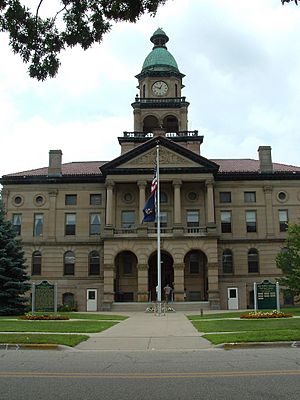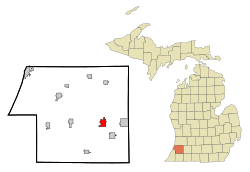Paw Paw, Michigan facts for kids
Quick facts for kids
Paw Paw, Michigan
|
|
|---|---|
|
Village
|
|

|
|

Location of Paw Paw, Michigan
|
|
| Country | United States |
| State | Michigan |
| County | Van Buren |
| Area | |
| • Total | 2.89 sq mi (7.48 km2) |
| • Land | 2.67 sq mi (6.90 km2) |
| • Water | 0.22 sq mi (0.58 km2) |
| Elevation | 732 ft (223 m) |
| Population
(2020)
|
|
| • Total | 3,362 |
| • Density | 1,261.54/sq mi (487.04/km2) |
| Time zone | UTC-5 (Eastern (EST)) |
| • Summer (DST) | UTC-4 (EDT) |
| ZIP code |
49079
|
| Area code(s) | 269 |
| FIPS code | 26-62980 |
| GNIS feature ID | 634488 |
Paw Paw is a village in the state of Michigan, United States. It is the main town, or county seat, of Van Buren County, Michigan. In 2020, about 3,362 people lived there.
Contents
About Paw Paw Village
Paw Paw is located where the east and south branches of the Paw Paw River meet. This is in the northeast part of Paw Paw Township. The village was officially started in 1837. It is in the southwest part of Michigan, right on Interstate 94 (I-94). Paw Paw is about 20 miles (32 km) west of Kalamazoo.
The village gets its name from the pawpaw trees. These trees used to grow a lot along the Paw Paw River.
History of Paw Paw
Paw Paw has an interesting history, including some tough times.
- In 1864, Malinda Russell, an African American cookbook author, came to Paw Paw. She had to leave her home in Tennessee. In 1866, she published Domestic Cook Book: Containing a Careful Selection of Useful Receipts for the Kitchen. This was the first known cookbook by a Black woman in the United States. She hoped to earn money from the book to return home with her son.
- Soon after her book was published, a big fire destroyed much of Paw Paw.
- Later, on June 13, 1888, another fire broke out. This fire destroyed seven buildings, including 11 businesses.
Paw Paw's Grape Industry
Paw Paw is in a farming area. Its main crop is grapes. These grapes are used to make local Michigan wine, juice, and jellies. Famous wineries like St. Julian Winery and Warner's Winery started here.
Every year, Paw Paw hosts an exciting Wine and Harvest Festival. This festival usually happens the weekend after Labor Day. It's a big celebration of the village's farming roots.
- The festival has a beer tent and a bandstand with live music.
- A popular event is the grape stomping competition, where people stomp grapes with their bare feet!
- You can enjoy carnival foods and watch fireworks over Maple Lake.
- For three days, the village celebrates its fruit-growing, juice, and wine-making industries.
- Other activities include wine tasting, a 5K run, and a bicycle classic.
Paw Paw in Pop Culture
The story "Paw Paw for Jesus" was featured on the popular radio show This American Life from NPR.
Important Places
Van Buren County Courthouse
The Van Buren County Courthouse is a very important building in Paw Paw. It is located at 212 E. Paw Paw Street. The first election in Paw Paw was held here in 1837. The courthouse was updated in 1999. It is listed in the National Register for Historic Places.
Geography of Paw Paw
Paw Paw is a village with a total area of about 2.89 square miles (7.48 square kilometers). Most of this area, about 2.67 square miles (6.90 square kilometers), is land. The rest, about 0.22 square miles (0.58 square kilometers), is water.
Major Roads
 I-94
I-94 M-40
M-40- Red Arrow Highway
Population of Paw Paw
| Historical population | |||
|---|---|---|---|
| Census | Pop. | %± | |
| 1870 | 1,428 | — | |
| 1880 | 1,482 | 3.8% | |
| 1890 | 1,391 | −6.1% | |
| 1900 | 1,465 | 5.3% | |
| 1910 | 1,643 | 12.2% | |
| 1920 | 1,556 | −5.3% | |
| 1930 | 1,684 | 8.2% | |
| 1940 | 1,910 | 13.4% | |
| 1950 | 2,382 | 24.7% | |
| 1960 | 2,970 | 24.7% | |
| 1970 | 3,160 | 6.4% | |
| 1980 | 3,211 | 1.6% | |
| 1990 | 3,169 | −1.3% | |
| 2000 | 3,363 | 6.1% | |
| 2010 | 3,534 | 5.1% | |
| 2020 | 3,362 | −4.9% | |
| U.S. Decennial Census | |||
In 2010, there were 3,534 people living in Paw Paw. There were 1,499 households, and 862 families. The village had about 1,324 people per square mile (511 per square kilometer). Most residents (92.3%) were White. About 2.3% were African American, and 5.9% were of Hispanic or Latino background.
The average age in the village was 36.4 years old. About 24.2% of the people were under 18 years old.
Education in Paw Paw
The schools in Paw Paw are part of the Paw Paw Public Schools district. This district serves the community and provides education for local students.
Famous People from Paw Paw
Many interesting people have connections to Paw Paw:
- Jason Babin – A football player who was a first-round NFL draft pick.
- John Bonamego – A football head coach at Central Michigan University. He also coached for several NFL teams.
- Frank R. Gooding – He was the Governor of Idaho and a U.S. Senator. He grew up in Paw Paw.
- Doane Harrison – An Oscar-nominated film editor, known for working with director Billy Wilder.
- Bill and Wade Killefer – Baseball players from the early 1900s.
- Joseph Labadie – A leader for workers' rights and a political activist.
- Loretta Long – An actress and educator, famous for playing "Susan Robinson" on Sesame Street.
- Charlie Maxwell – Known as "Old Paw Paw," he was a baseball player for teams like the Detroit Tigers.
- Jerry Mitchell – A Tony Award-winning choreographer.
- Don Moorhead – A football player for Michigan and a Canadian Football League quarterback.
- Malinda Russell – A pioneering cookbook author.
- A. W. Underwood – A person from the 1800s who some believed could make things catch fire with his mind.
- Abraham Wechter – A skilled guitar maker.
- Shayne Whittington – An NBA basketball player for the Indiana Pacers.
See also
In Spanish: Paw Paw (Míchigan) para niños



